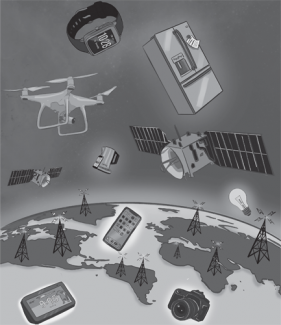Environmental professionals know more than most people why we can depend on our household taps to supply on-demand, clean drinking water. We can thank federal and state legislation, the work of water utilities, and local requirements. But after regulators and scientists set the standards, who is in charge of achieving them? The answer is engineers, who form a vital yet seldom heralded component in our system of environmental protection. Whether it is reducing air emissions of hazardous substances, mitigating harmful discharges into waterbodies, or reducing toxic impurities in drinking water, it is the engineer’s craftmanship that achieves society’s public health and natural resource goals.
I’ve taken a peek into the work of engineers through an online course on these everyday infrastructure systems that, as big as they are, usually go unnoticed. One especially impressive example is the Catskill Aqueduct. This vast underground tunnel runs unseen between the Catskill Mountains and New York City for 92 miles, conveying 40 percent of the city’s drinking water supply. Built between 1907 and 1917, it uses nothing but the power of gravity to carry 600 million gallons of pure water per day to the country’s largest metropolis.
In its long voyage, the Catskill Aqueduct crosses under the Hudson River, plunging 1,140 feet below the surface of the stream on one end and syphoning back up on the other side—a six-mile journey in high-pressure concrete-lined tubes.
The engineer and teacher Stephen Ressler, Ph.D., calls this Hudson crossing “one of the world’s great civil engineering achievements.” Yet we rarely appreciate, or perhaps even know of, this impressive feat of human ingenuity and others like it throughout the United States.
Ressler provides a window into these infrastructure systems in his online lecture series Everyday Engineering. The class of 36 half-hour sessions is available through The Great Courses, run by Virginia-based The Teaching Company. Everyday Engineering provides an overview of “the products of modern engineering that have the most substantial influence on our lives,” says Ressler early on in the series. These are “the everyday technologies that surround us in our homes and workplaces, the infrastructure systems that have been so beautifully integrated into the fabric of modern civilization that they’re practically invisible and are inevitably taken for granted.”
Let’s stick with drinking water as an example. Setting up a system to provide instantaneous water for a city of millions requires a dizzying array of technologies. Engineers achieve this by “thinking systemically,” Ressler tells me during an online interview—it was a chance, via Zoom, to be able to talk back to the lecturer who appears on my laptop. According to the professor, we first need a water source. That usually requires building a dam to create a reservoir of readily available water. To ensure that the drinking water isn’t loaded with contaminants, the dam must be built “in an area often far removed from the urban zone to be served—beyond extensive development.” Once we have a reservoir, “engineers have to make sure the water in it doesn’t get stale or contaminated, and doesn’t have a lot of organic material growing in it.” Engineers must also ensure there’s extra storage capacity in case of flooding, and account for the risk of drought. Next, water needs to get to the city’s residents through a transmission system of covered channels, mains, and service lines. As the water needs to be clean before reaching consumers, it will also pass through a treatment plant, where engineers have deployed a variety of mechanical and biological processes to remove impurities. Finally, water is pumped into high-rise storage towers at the edge of the city, from which gravity will feed the lines reaching homes and businesses.
At every step of the drinking water delivery system—from collection, to treatment, to distribution—engineers must fulfill federal, state, and local environmental policy mandates. The Safe Drinking Water Act, for example, sets maximum contaminant levels in drinking water, which engineers are in charge of achieving. Engineers also need to site and design water sources to be free of contamination. And the law requires states and localities to maintain the integrity of their water distribution systems—a task handed to the engineers who create and upgrade these structures.
By the time water reaches your tap, it will have traveled perhaps hundreds of miles and undergone several rounds of disinfection and treatment. After it leaves your drain in the form of wastewater, engineering continues to carry out the mandates of laws like the Clean Water Act, treating the water through complex physical and biological processes to meet effluent limits before returning it to a local stream. In this way, environmental policy and engineering work hand-in-hand, each discipline informing the other in carrying out a blueprint for protecting public health and ecosystems.
Beyond water, everyday engineering provides us with the electrical power that fuels our lighting, appliances, hot water, and heating systems; the local roads, highways, and railway systems we use for transportation; and the solid waste collection and management systems that pick up our trash and recycling. So much of our daily lives, and our daily resource consumption, interacts with complex local and regional infrastructure networks. But many of us know little about these engineering systems, not to mention their role in environmental impacts. The connections are so overlooked, in fact, that even an engineer may not spot them at first glance.
The professor embarked on a journey of learning about sustainability while developing his Everyday Engineering course. A civil engineer by training, Ressler taught at West Point for 21 years and is now an emeritus professor there. He also served in the U.S. Army Corps of Engineers for 34 years, beginning as a combat engineer, and later becoming deputy commander of the New York District of the Corps.
Though he is quick to point out that he has no formal training in environmental engineering, Ressler’s evolution from “someone who was largely uninterested in sustainability to someone who is a true believer,” as he puts it, appears a natural progression for this lifelong learner.
Even before teaching for The Great Courses, he and his wife were “aficionados” of the online series: “We have a whole bookcase of The Great Courses CDs and DVDs.” During a sabbatical from teaching, Ressler emailed their customer service department on a whim to ask about teaching an engineering course. Since that first cold email, The Great Courses has featured a growing roster of Ressler-taught classes: In addition to Everyday Engineering, these include Understanding Greek and Roman Technology, Understanding the World’s Greatest Structures, Do-It-Yourself Engineering, and a fifth under production on catastrophic engineering failures.
Ressler is a lively instructor, with an emphatic way of speaking that’s immediately engaging. His popularity on The Great Courses site—there is a rating system—is in large part due to his trademark use of working models. These functional, miniature versions of engineering structures show how an arch bears weight, or how a dam creates a water reservoir, by demonstrating physical concepts in real time. He credits his military academy experience for this technique, as using physical models is “in the fabric of the West Point academic philosophy,” Ressler says.
While developing Everyday Engineering, Ressler began researching passive solar and other energy-efficient designs in residential housing. These principles were natural entry points into the field of sustainability; after all, “When you get a huge return for absolutely minimal investment, that’s very enticing to an engineer,” he says. But as he looked further, he began to consider how environmental issues fit into the broader purpose of engineering as a profession. “I began to think about the broader professional aspects of what it means to be an engineer, in a world where our decisions will have a tremendous impact on future generations.”
He reached a simple, yet powerful conclusion: “Sustainable engineering is just morally responsible engineering.” The revelation stems from his education in ethics as an engineer. Licensed engineers—mostly working in civil and environmental engineering—must subscribe to a code of ethics as part of their licensure process. “Protecting public health and safety is, and has always been, the paramount principle embedded in our code of ethics,” he says.
A licensed engineer himself, and an experienced evaluator of accreditation programs through his work with the American Society of Civil Engineers, Ressler began to probe the meaning of public health and safety when it comes to future generations. “Why should we place less value on their health and safety, than on that of people today?” he asks.
“Sustainability simply means my grandchildren should have access to the same resources, the same clean air, the same clean water, and the same viability of the planet into the future as we have, or perhaps better,” he says. “By the time I was done with the course, I found myself being a sustainability advocate.”
Ressler is not alone. A growing number in the engineering community have begun to recognize the importance of sustainability. One proponent is the American Society of Civil Engineers, an organization Ressler is extensively involved with. ASCE has set sustainability as a strategic goal, and recently made efforts to revamp its professional code of ethics for civil engineers. “This new code of ethics makes a very powerful case for sustainability and for the environment,” Ressler says.
In his Everyday Engineering lectures, Ressler identifies sustainability as “the most important trend in the world of engineering and technology today.” That’s because engineering is fundamental to achieving almost any environmental or sustainable development goal. For a product, building, or power source to be sustainable, environmental standards need to be “designed in from the outset,” he says.
In one video lecture, Ressler gestures toward a standard pop-up toaster on his classroom table. “Your new toaster won’t be maintainable unless the designer makes better accommodations for disassembly and repair—than this!” Stumped, he examines the unwieldy cooking apparatus. “How do I get this apart, anyway?”
For this reason, Ressler says designers are the ones principally responsible for sustainability. So how do we motivate them to embed energy efficiency and zero-waste principles? He argues the best way is for companies to recognize that taking green measures is good for business, and to voluntarily opt for these standards. For example, building a Leadership in Energy and Environmental Design (LEED)-certified headquarters building or other facility can help boost a corporation’s public image, and cut energy and water supply costs at the same time.
Government action and incentives are also powerful tools. “For instance, building sustainability requirements into the codes and standards that we use as the basis for design,” Ressler says. These include building codes, which are developed with technical input from professional societies like the American Society of Civil Engineers before being adopted by government entities. ASCE and other societies are currently updating codes to reflect higher standards of sustainability. The good news is, “Once you build sustainable design into the codes and standards, engineers will comply. There’s no question about it.”
Despite the many ways technology helps fulfill society’s environmental goals, engineering has also played a role in some of history’s greatest environmental catastrophes. Ressler spoke with us as he wrapped up post-production on his newest course, Epic Engineering Failures, which covers case studies like the Chernobyl nuclear meltdown and the Deepwater Horizon oil spill. These incidents offer fresh insight on how engineers can contribute to sustainability: “The most important answer is, ‘Don’t build nuclear power plants that explode and spew radiation across an entire continent,’” Ressler writes in a tongue-in-cheek email.
In reality, the reasons for these colossal failures are surprisingly complex. Ressler argues that one contributing factor for some disasters is a widespread policy governing the engineering profession, called the industrial exemption.
Like lawyers and doctors, engineers require a state-issued license to do certain types of work. But the industrial exemption policy means that engineers working in industry—a definition that varies from state to state—are not required to obtain a license from professional bodies. “Essentially, the corporation takes on both the responsibility and the liability that’s normally associated with the work that a licensed professional does,” Ressler explains. He cites a 2015 law review article by Paul Spinden that calls engineers “a striking enigma” compared to other licensed professionals. “An overwhelming majority of engineers—somewhere around eighty percent—do not pursue licensing as a professional engineer,” Spinden writes.
Licensing holds engineers accountable to a high standard of protecting public health and safety—values espoused in the code of ethics required for licensed engineers. As Ressler puts it, a licensed engineer “is operating under an ethical obligation to protect public safety, and can and will lose his or her license if some aspect of the design turns out to be flawed to the extent that somebody gets hurt.”
The industrial exemption warps this picture. “Industrial exemptions are granted to engineers in corporate bureaucracies—an organizational structure that causes them to be completely beholden to their managers, and incapable of exercising the sort of autonomy that an engineering professional should be able to exercise to protect public safety,” Ressler tells me.
He points to the Deepwater Horizon oil spill as one instance where the industrial exemption likely played a role—the disaster is one example in his Epic Engineering Failures series. The 2010 drilling rig explosion released four million barrels of oil into the water, led to the death of 11 crew members, and polluted the region’s unique ecosystems. To date, BP has paid more than $60 billion in penalties, natural resource damages, and other costs.
A series of flawed management decisions led to the tragedy. In a 2011 report to President Obama, the National Commission on the BP Deepwater Horizon Oil Spill and Offshore Drilling identified several issues in the cement job designed to seal the bottom of the Macondo well. BP managers and BP’s contractors also failed to adequately perform tests to check for leaks in the well. For one of these tests, the commission concluded, “It is now undisputed that the negative-pressure test at Macondo was conducted and interpreted improperly.” The report goes on to find that any final chances to catch issues during the temporary abandonment of the well were also missed. As Ressler says, “It was an amazingly multilayered failure.”
Deepwater drilling is inherently risky, the report makes clear. Yet despite these risks, the commission found that the largest offshore oil spill in U.S. history was “avoidable,” and “can be traced back to a single overarching failure—a failure of management.”
Indeed, “Better management by BP, Halliburton, and Transocean would almost certainly have prevented the blowout by improving the ability of individuals involved to identify the risks they faced, and to properly evaluate, communicate, and address them,” the report states. Addressing these risks would have required leaning on the specific know-how of engineers: “BP did not have adequate controls in place to ensure that key decisions in the months leading up to the blowout were safe or sound from an engineering perspective.”
The commission stated that the incident’s “root causes are systemic.” Ressler, Spinden, and others in the pro-licensure community argue that one of these systemic causes was the industrial exemption. When all liability and responsibility are in the hands of corporate managers, industry engineers lack the professional autonomy needed to make judgment calls to ensure safety. “That doesn’t mean failures will never occur when the work is being done by licensed engineers,” Ressler clarifies. “But it sure seems to me that these mega disasters are often the result of unlicensed engineers operating within corporate bureaucracies, where the engineers’ professional judgments about safety are constrained by conflicting corporate priorities.”
Industrial exemption is “a scandal that nobody wants to take on because the corporate interests are very strong,” Ressler tells me. From his perspective, it’s an issue raised “only in the fairly obscure literature of engineering professionalism in the licensure community.”
According to Spinden, “The industrial exemption is a natural outgrowth of a profession, which, from the outset, has been closely allied with the industrial firms it serves.” But engineering goals can sometimes be at odds with business motives. On this tension, the presidential commission concludes, “Whether purposeful or not, many of the decisions that BP, Halliburton, and Transocean made that increased the risk of the Macondo blowout clearly saved those companies significant time (and money).”
Ressler chooses stronger language to describe the issue. Flawed management decisions “were made in pursuit of corporate objectives,” he says. “They were all about making profits to the exclusion of following good engineering procedures and following sound safety procedures. It was a wanton disregard of all these safety systems that are designed precisely to prevent this kind of a problem.”
Spinden writes that other major engineering disasters have been influenced by the industrial exemption, including the 1986 Challenger tragedy and innumerable lawsuits for faulty consumer products. He argues that to prevent future incidents, “Nothing short of outright elimination of the exemption will be enough.”
Ressler agrees wholeheartedly. “Nothing about our current system has changed to cause me to believe that another Macondo blowout isn’t in our future.”
As we consume increasing amounts of fossil fuels, many of today’s most challenging natural resource and pollution issues will continue to be implicated by the inherent risks of the engineering required to drill in deeper and more remote areas. On the flip side, engineers will play a key role in a transition to renewable power, designing the energy sources and building a reliable electrical grid to reach our climate mitigation goals. Investments as a result of the bipartisan infrastructure law will only accelerate these efforts.
This ever-growing role of engineering in our lives means that understanding modern environmental policies is almost impossible without basic knowledge of these technologies. In Ressler’s Everyday Engineering course, he points out that “issues surrounding the environmental impact of technology can be quite complex.” For this reason, “unambiguously correct responses to these issues are rarely available.”
An illustrative example is the ongoing debate over methane recovery systems in landfills. Under the Clean Air Act, landfills are required to systematically collect and control landfill gas emissions for safety reasons and to reduce the climate impacts of methane, a product of the breakdown of organic matter. Landfills used to fulfill this requirement by burning off the gas with controlled flares. But nowadays, gas recovery systems—which either burn the gas to produce hot water or electricity, or process it to sell to a local gas utility—are becoming increasingly common. Some environmental groups have opposed these projects, arguing that the system will incentivize landfill owners to maximize gas production. To do so, owners may delay the installation of a landfill cap, which seals the top of a dump site to minimize water infiltration. That’s because if more water seeps in a landfill, solid waste will decompose more quickly, and thus produce more methane.
Ressler uses this broad-stroke issue to highlight his most compelling argument for learning about everyday engineering: it can make us all better citizens. Back in his online classroom, he shows us his local newspaper, covered in headlines about new investments in the local highway and controversies about shale gas. “As an engaged citizen, I should take well-reasoned positions on issues like deregulation of the power industry, public investment in transportation infrastructure, and the environmental impact of shale gas exploration—and I should consider these issues when I vote for the officials who influence these policies. But can I really take a well-reasoned position on any of these issues without some understanding of the associated technologies?”
To find out, stay tuned. TEF
Akielly Hu is associate editor of The Environmental Forum. You can nominate people for Profiles by emailing her at hu@eli.org.








